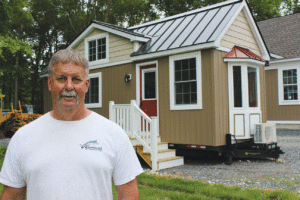
Mike Peter took on a project to challenge himself after seeing tiny houses featured on television shows. What started out as a hobby has gained a lot of interest, he said, to the point where he has plans to build more. However, it’s not so small that it can’t have a second floor, inset. (Photo by Sean Cloughterty)
In his 35 years building custom homes, Mike Peter of Centreville has had a lot of unique projects.
Over the past winter, Peter said he added a tiny house to that list when the carpenter took on the project to challenge himself after seeing the small dwellings featured on television shows.
What started out as a “hobby” has gained a lot of interest, Peter said, to the point where he has plans to build more.
“I had a ball building it,” he said. “I took my time with it. I like a little challenge.”
With space in the tiny house at such a premium, Peter said he spent a lot time with the design, making sure every inch was maximized and efficiently used. It paid off with enough room for a full kitchen, full bath and two sitting areas.
“Most people go, ‘Man it’s not that small, really’” Peter said of those who have toured the house.
Peter opted to for a 10-foot width, a few feet wider than the typical houses he saw in researching the project but still able to travel down the road and it makes a big difference in the ease of getting from one part to another.
“It takes a different type of planning,” Peter said. “You’ve got to fit all this into a neat and tidy space. The full kitchen and full bath was a big priority of mine.”
The so-called “Tiny House Movement has its roots in the 1970s, with people looking to simplify their lives, practice conservation and add an element of adventure and mobility.
Popularized by a few television shows on the subject, tiny houses like Peters’ are getting more consideration as a scaled-down place to live.
With Peter entering the tiny house world, he’s one of a few if not the only builder on the Mid-Shore.
Another maker, Tiny House Container in Ridgely, focuses on using shipping containers as the house’s frame.
While there’s not a strict definition, tiny houses generally fall in the 600- to 400-square-foot range or smaller.
Most localities don’t have zoning or occupancy rules that effectively govern where a tiny house can be set so that’s another area that will need future discussion.
Though the state or county doesn’t have specific code for building tiny houses, Peter still had his inspected after it was built to provide some assurance to prospective buyers.
Peter said trailers for the foundations of his next round of small houses have been ordered.
In the next design, Peter said he wants to work in a screen porch or awning and “bump-out” spaces similar to modern RVs on the outside and a spiral staircase to gain even more space on the inside.
“The next one I’ll be able to pop up a lot quicker,” he said. “I wasn’t in any big hurry with this one.”





